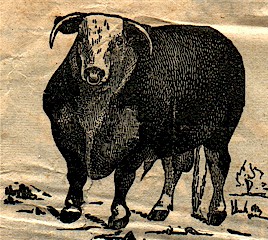Madison County was organized December 14, 1818 with Fredericktown as the county seat. The county is situated 100 miles south of St. Louis and 30 miles west of the Mississippi River. In 1867, the county was made up of six hundred square miles and had anywhere from 18 to 20 thousand acres in cultivation. In 1878, one-sixth of the land or 64 thousand acres were in cultivation, and property value was $5 to $30 per acre for improved land or $3 to $15 per acre for unimproved land. One year later, one-third of the land or about 9,700 acres were cultivated.
The countryside was very rough, broken, and hilly but rich with minerals. Many rivers (including Big St. Francis to the west, Little St. Francis, Castor to the East, and Twelve Mile), creeks, and springs ran throughout the county. Ridges between those waterways were often rich and fertile, having red or yellow clay soil and producing fine fruits or small grains in some cases. Bottoms around the waterways were exceedingly fertile with black sandy soil, producing 50 to 75 bushels of corn per acre or 15 to 30 bushels of wheat per acre. Vast forests were a major part of the land and were composed of pine, cypress, poplar, cedar, black walnut, and cherry trees. The tillable lands produced rye, oats, timothy, clover, corn, wheat, barley, vegetables, fruits, hemp, cotton, and tobacco. During 1878, the land was producing 20 to 75 bushels of corn, 5 to 30 bushels of wheat, 10 to 40 bushels of oats, 10 to 20 bushels of rye, and 1 to 1˝ tons of timothy per acre.

There were a few mines in Madison County, but only one, Mine La Motte, was profitable. The mine was worked as far back as 1720’s by early French settlers and was estimated to be 21,010 acres. In 1867 the mine produced 1,312,130 pounds of lead and was worked by only 100 men. The average price for lead that year was about eight cents per pound, making the lead worth $104,970.40. Some of the minerals that could have been found in the county were iron, lead, copper, nickel, cobalt, and zinc.
In 1874, a Chinch bug problem arose and because there were not very many pesticides in use, other means were found to control them. Many insects were destroyed by burning the stubble left over from crops. Crops that year were cut short one-fourth of the growing season, except winter wheat, which matured before the insect problem arose.
The “Grasshopper Year” was during 1875. Vast hordes of Rocky Mountain locusts invaded Missouri in 1874 and laid their eggs. Eastern Missouri was then assaulted by them in 1875. All crops were destroyed and Madison county farmers lost heavily. Crops were replanted but reoccurring swarms ate them and they were threatened with famine.
Livestock raised included horses, mules, oxen, pigs, cattle, sheep, and poultry. Very little energy was displayed in the improvement of livestock by the introduction of more improved breeds. Yet, a small number of Shorthorn cattle, Berkshire and Poland China hogs, Cotswold and Southdown sheep were found in the county during 1878. Bees were also cultured and in 1879 there were 400 stands of them.
During 1879, the population of Madison County was 9,000. There was six water grist mills, two steam grist mills, five saw mills, 23˝ miles of railroad tracks, 7 miles of gravel road, 626 town lots, 46 school houses with $9,000 in the school fund, five miles of osage orange hedge fencing, and one dairy farm – F. G. Grigery’s 16 cows that averaged 640 gallons of milk per day.
-
Agriculture Report of Missouri, 1867
-
Agriculture Report of Missouri, 1874
-
Agricultural Report of Missouri, 1878
-
Agricultural Report of Missouri, 1879